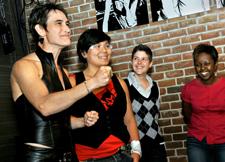When the first women’s bathhouse party took place on Sep 14, 1998 the organizing committee had no idea of the drama that lay ahead.
“We all signed up to organize little parties two or three times a year,” said Loralee Gillis, who spent seven years on the bathhouse organizing committee, at a Sep 17 event celebrating the committee’s 10th anniversary, “and then [in September 2000] we got raided. No one saw that coming, but we found ourselves embroiled in this huge battle, which I really think had huge social political and historical implications.”
Gillis was one of several former committee members to talk about the history of the bathhouse, it’s impact on Toronto’s women’s sex culture and on their own lives at the event, held at Slacks. The now-infamous police raid of the Pussy Palace party was a recurring theme.
Gillis recollects chairing a community meeting after the raid to discuss how the committee would respond. “The crowd wanted to march on police headquarters and I didn’t know what to do. A man I knew from AIDS Action [Now] who was around at the bath raids in the ’80s told me, ‘Loralee, this is what you do. I’ll get you marshals, you lead these people over there and you find a girl and kiss her.’
So we went to police headquarters and had a kiss-in. To me this was a passing of the torch. So that was a really powerful experience.”
The ensuing legal battle lasted until late 2004, when the Toronto police force agreed to award $350,000 in damages and provide queer sensitivity training to all officers.
Suzy Yim, a former member who plans to rejoin the committee, notes the national significance of the women’s and trans bathhouse’s existence. “We can tend to take for granted, being in Toronto, how amazing it is to have a space for women and trans people to go out and fuck,” she says. “People come all the way from BC to attend this event.”
“Men’s communities… have had bathhouses as far back as the Romans,” says former committee member Carol Thames, “but women have taken that idea and redefined it. It’s a wonderful experience to see the diversity of acts and sexual practices at these events.”
Carlyle Jansen, the sole remaining founding member of the committee, says it has been exciting to see the culture of the bathhouse evolve during the last decade.
“I love the organic way people have claimed it as their own,” she says. “People come up with ideas — the brat room, the confessional, strip poker games, a violet wand.
A while ago I thought, ‘Let’s do a G-spot room!’ I had no idea if it would fly but now there are lineups for it.”
In addition to the regular bathhouse events, which are open to all women and trans people, the committee has also offered tailored events including Sugar Shack, an event for people of colour, and Kinky Kitty, a fetish-oriented event.
In keeping with its desire for diversity the committee is currently recruiting people of colour, particularly trans people, to join its ranks.
“We ask ourselves, ‘How can we meet the needs of a diverse population?’ It’s evolving, and it’s exciting that it’s not the same thing every time,” says Jansen.
The evolution continues Thu, Sep 25 at the 10th-anniversary edition of the bathhouse, entitled Decadence and Debauchery.
New this time will be the dance card — a card with 10 questions that attendees will be asked to fill out by talking to someone new.
“Some women and trans folk now know how to work the bathhouse, but this is a tool for newer or shyer folk,” says Jansen. “I love talking to the people who are nervous about going. Seeing them later, the night of, and watching them melt into themselves, discover themselves and lose their fear… it’s a privilege and a joy to see.”


 Why you can trust Xtra
Why you can trust Xtra


